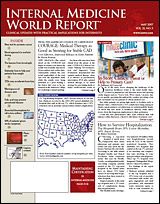Publication
Article
Internal Medicine World Report
Bronchial Thermoplasty Beneficial for Refractory Asthma
Author(s):
From the American Academy of Allergy, Asthma & Immunology
SAN DIEGO—It may be possible to zap refractory asthma by heating up targeted airway walls with bronchial thermoplasty, an investigational procedure that delivers precisely controlled thermal energy with a tiny catheter, British investigators reported at the American Academy of Allergy, Asthma & Immunology annual meeting.
“We saw some outstanding effectiveness with this approach,” said lead investigator Robert Niven, MD, of South Manchester University Hospital’s National Health System Trust, Manchester, United Kingdom.
Bronchial thermoplasty is performed on an outpatient basis using a standard flexible bronchoscope, which is introduced through a patient’s nose or mouth. The Research in Severe Asthma (RISA) trial, which was conducted at 8 hospitals in 3 countries, evaluated the safety and efficacy of bronchial thermoplasty in patients with severe asthma who did not respond to optimal care in asthma clinics.
The trial included 32 patients (mean age, 41 years) with severe persistent asthma who remained symptomatic despite taking >750 µg fluticasone (Flovent) or an equivalent medication, and long-acting beta-agonists plus maintenance oral corticosteroids. Patients randomized to bronchial thermoplasty underwent 3 sessions to treat all accessible airways. The control group received only standard asthma medications. All patients continued taking their baseline asthma medications for 22 weeks after their last clinic visit or bronchial thermoplasty treatment.
“The main outcomes at 6 months were that patients who had this procedure had a 15% improvement in their FEV1 [forced expiratory volume in the first second]. They also reduced their use of reliever bronchodilator by an average of 27 puffs per week, which is a dramatic overall reduction in rescue medication use, approximately 50%,” said Dr Niven.
Controlled thermal energy is delivered to the airway walls to reduce the volume of the muscles that narrow the airways. Patients are under conscious sedation and usually return home the same day. Currently, this approach requires 3 treatment sessions approximately 3 weeks apart, with each treatment taking about 45 minutes.
The most common adverse events were wheezing, cough, chest discomfort, dyspnea, productive cough, and discolored sputum. Most events occurred within 24 hours of the procedure and resolved within 1 week. There were more hospitalizations for respiratory-related events in the bronchial thermoplasty group than in the control group. However, posttreatment, the number of hospitalizations for respiratory-related events was similar in both groups.
IMWR
“This procedure may turn out to be a massive breakthrough in asthma treatment. If the trials continue to go as well as they are going now, this approach may turn out to be as big as doing angioplasty or stenting in coronary artery disease. So physicians need to know about this,” Dr Niven told .
New England Journal of Medicine
A previous study including more than 100 patients published in the (2007; 356:1327-1337) had similar positive findings.
John H. Krouse, MD, PhD, of Wayne State University School of Medicine, Detroit, advised caution, saying that even larger studies with longer follow-ups are needed. “This approach…at present must be considered purely experimental,” he told IMWR.






